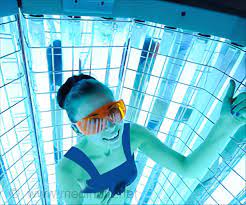 PUVA (psoralen and UVA) is an ultraviolet light therapy treatment for skin diseases: eczema, psoriasis, graft-versus-host disease, vitiligo, mycosis fungoides, large plaque parapsoriasis, and cutaneous T-cell lymphoma, using the sensitizing effects of the drug psoralen.
PUVA (psoralen and UVA) is an ultraviolet light therapy treatment for skin diseases: eczema, psoriasis, graft-versus-host disease, vitiligo, mycosis fungoides, large plaque parapsoriasis, and cutaneous T-cell lymphoma, using the sensitizing effects of the drug psoralen.
The psoralen is applied or taken orally to sensitize the skin, then the skin is exposed to UVA.
PUVA is a form of phototherapy used in the treatment of certain skin conditions, especially those that involve abnormal cell growth.
IDuring PUVA therapy, a patient is first given psoralen either orally or applied topically.
The psoralen is then activated by UVA light, typically delivered through a special machine known as a UVA cabinet or UVA chamber.
The UVA light penetrates the skin, targeting and affecting the cells that contribute to the skin condition being treated.
PUVA therapy is commonly used to treat conditions like psoriasis, vitiligo, eczema, and cutaneous T-cell lymphoma.
It can help to reduce inflammation, slow down the rate of skin cell turnover, and stimulate repigmentation in certain conditions.
The most common side effects include redness and burning of the skin, itching, dry skin, and nausea caused by the psoralen.
Long-term risks associated with PUVA therapy include an increased risk of skin aging, cataract formation, and skin cancer.
Photodynamic therapy is the general use of nontoxic light-sensitive compounds that are exposed selectively to light, whereupon they become toxic to targeted malignant and other diseased cells.
PUVA therapy is often classified as a separate technique from photodynamic therapy.
Psoralens make the skin more sensitive to UV light.
Psoralens are photosensitizing agents found in plants naturally and manufactured synthetically.
Psoralens are taken orally or can be applied directly to the skin.
PUVA allow UVA energy to be effective at lower doses.
UVA in PUVA are highly effective at clearing psoriasis and vitiligo.
In vitiligo, PUVA works by increasing the sensitivity of melanocytes to UVA light.
LED PUVA lamps intensify light compared to fluorescent type lamps, and reduces treatment time, makes treatment more effective, and enables to use a weaker psoralen.
For small areas of vitiligo, it is possible to use psoralen as drops, applied only on the spots.
For larger area, the psoralen is taken as a pill.
Long term use of PUVA therapy with a pill has been associated with higher rates of skin cancer: the non-ionizing radiation of UVA light as well as the psoralen intercalation with DNA contributing to genome instability.
